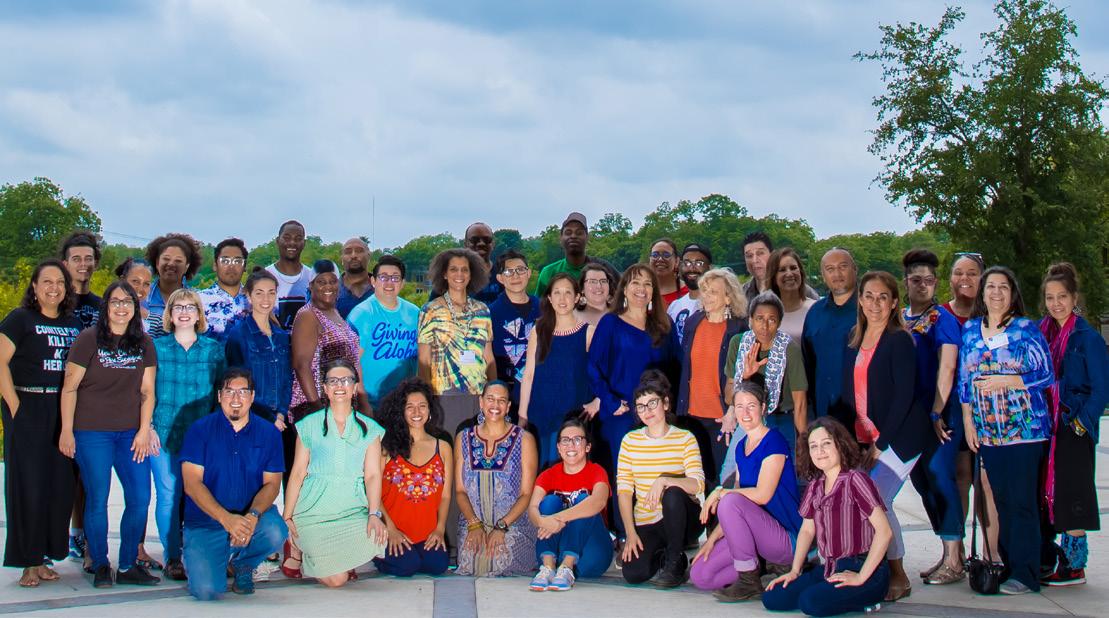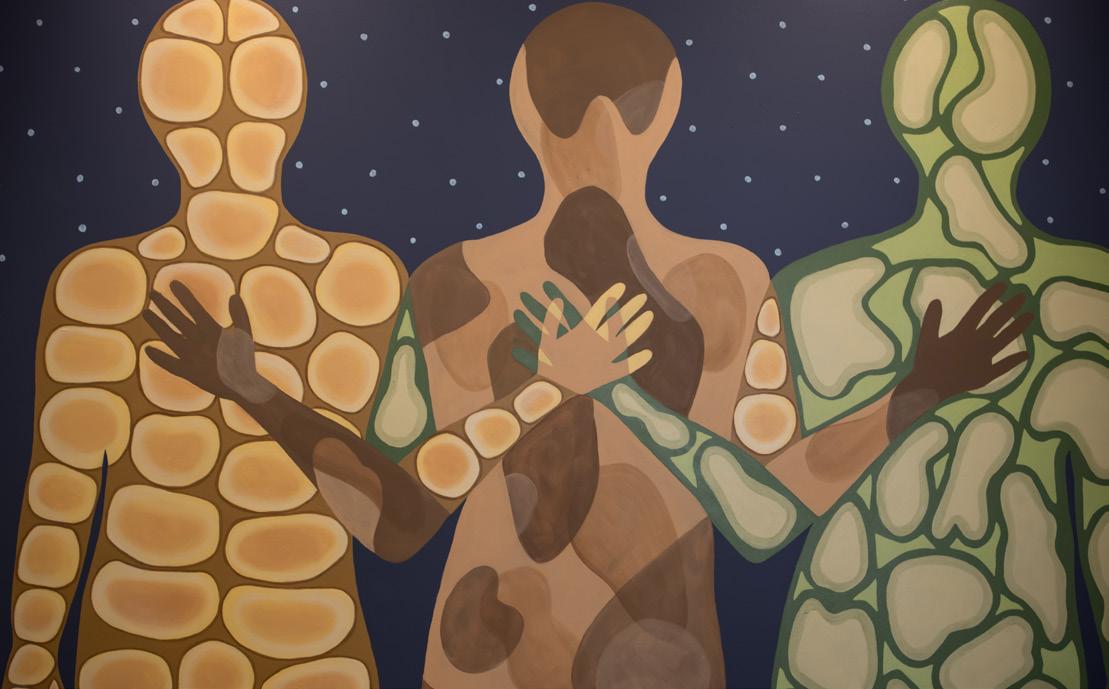
6 minute read
Background
The Intercultural Leadership Institute (ILI) was created out of a shared vision among four cultural organizations to create leadership opportunities for artists, culture bearers, arts practitioners and change-makers.
In Native Hawaiian, ‘ili means skin – the outer layer that holds together something vital. Like the Native Hawaiian ‘ili, ILI’s intercultural approach to leadership aims to hold together a space for resilience and resourcefulness while emphasizing overlapping experiences, shared spaces and mutual accountability - all in pursuit of cultural equity. Since 2015, when ILI launched its pilot leadership fellowship, ILI has designed and delivered people-centered leadership fellowships with a cultural context that challenges the dominant social norms that permeate the arts and culture sector.
Advertisement
Prior to launching ILI, the four founding cultural organizations and core partners1 were already delivering distinct programming in service to their respective communities:
1. First Peoples Fund honors and supports the collective spirit of First Peoples artists and culture bearers.
2. Alternate ROOTS supports the creation and presentation of original art based in the south that is rooted in community, place, tradition or spirit.
3. PA’I Foundation preserves and perpetuates Native Hawaiian arts and cultural traditions for future generations.
4. National Association of Latino Arts & Cultures (NALAC)2 delivers programs that stabilize and revitalize the US Latino arts and cultural sector via funding, leadership training, convenings, research, and advocacy.
In 2017, the Mississippi Center for Cultural Production (SIPP Culture) joined ILI as a core partner organization. Sipp Culture utilizes research, development, and local agriculture to honor the history and build the future of Utica, MS. ILI welcomed First Alaskans Institute and the International Association of Blacks in Dance as new partner organizations in 2020. First Alaskans Institute helps develop the capacities of Alaska Native people and their communities to meet the social, economic and educational challenges of the future, while fostering positive relationships among all segments of our society. The International Association of Blacks in Dance (IABD) preserves and promotes dance by people of African ancestry or origin, and assists and increases opportunities for artists in advocacy, audience development, education, funding, networking, performance, philosophical dialogue, and touring.
The executive leaders of the 5 core ILI partner organizations. Pictured from left to right: Lori Pourier (President, First Peoples Fund), Michelle Ramos (Executive Director, Alternate ROOTS), Carlton Turner (Executive Director, Sipp Culture), Vicky Holt Takamine (Executive Director, PA’I Foundation, María López De León (President and CEO, National Association of Latino Arts and Cultures)
Together the ILI partners are united and guided by their commitment to an arts and culture sector that honors the collective truth of cultural histories, trust, mutual respect, and generosity of support for artists and arts leaders of color. ILI aims to:
» Build stronger strategic intercultural collaborations and solidarity in the field of arts, culture and social justice.
» Promote the traditional and contemporary practices of artists and culture bearers, establish an alternative pathway for them to work within existing structures and provide opportunity for them to create and normalize new structures.
» Advance and enhance the capacity of artists, culture bearers and arts organizations to pursue cultural equity and sustain their work in a changing environment.
» Impact the language, shift the attention, and endow greater resources in multiple sectors to support transformative practices of artists and culture bearers.
While the concept for ILI began through cultural organizing efforts back in 2012, today ILI has evolved and expanded its reach beyond the leadership fellowship and has increasingly responded to the needs of their collective communities. This report will describe ILI’s organizing, advocacy and funding efforts and their impact in the community during the height of the COVID-19 pandemic.
COVID-19 Pandemic
In late 2019, the world watched a fast acting, deadly respiratory illness, COVID-19, move across the globe, increasingly threatening lives and economies with each passing day. By March 2020, the World Health Organization (WHO) categorized COVID-19 as a global pandemic. Shortly after, cities around the world began to shut down. Almost every industry closed their doors, leaving many with very little resources, time, and hope for survival during the uncertainty. Effectively the world was facing a medical and financial crisis for which many communities, families and individuals were not prepared. Artists were among the first to be affected by the shutdown, many losing the ability to work and earn money.
In the midst of the global pandemic, arts leaders around the United States quickly rallied to design processes that could facilitate a swift dissemination of emergency funding to artists and arts organizations. To assist with reach and scale, three programs were initially created around the country to support the sector, they were:

1. The Artists Relief Fund organized by the Academy of American Poets, Artadia, Creative Capital, Foundation for Contemporary Arts, MAP Fund, National YoungArts Foundation, and United States Artists which funded artists.
2. The United States Regional Arts Resilience Fund an initiative of the Mellon Foundation in collaboration with the six regional arts organizations Arts Midwest, Mid-America Arts Alliance (M-AAA), Mid Atlantic Arts Foundation, New England Foundation for the Arts (NEFA), South Arts, and the Western States Arts Federation (WESTAF) which gave money to other arts organizations in their jurisdiction.
3. CARES Act Grant Program included direct grants from the National Endowment for the Arts, regional arts organizations, and state agencies for arts organizations nationwide to support staff salaries, facilities costs and fees for artists for contractual personnel.
These emergency funding programs3 were intended to reach as many artists and arts organizations as possible. They heavily relied on technology and existing networks to ensure that funding could be awarded. While many of the standard application procedures and fund administration efforts for these funding programs weren’t as stringent as standard philanthropic practices, the ILI partners sat on many of the grant panels for the aforementioned efforts and observed how the artists, culture bearers, arts practitioners and change-makers within the ILI community were largely being excluded from funding opportunities because the:
» funding criteria primarily prioritized organizations with annual budgets over $250,000 and/or organizations that could demonstrate a three year operating history and record of vision and noteworthy impact in their community
» the artists or arts organizations funded were either already grantees of the funders involved or within the network of the funders involved
» funds, although disseminated across the country, were primarily awarded to organizations located in cities with populations of 100,000+ people
» the applications were not as accessible to elders, those without the internet, and deaf or blind individuals
» individuals that identify as cultural bearers or workers aren’t named explicitly in many of the opportunities provided and therefore don’t apply to be considered
Community organizer, cultural bearers and cultural workers….I didn’t hear these terms until I moved to the south…art is connected to culture in the south…in a way that is bifurcated in the “higher” arts world…the higher art is different and distinct…the tie to culture and tradition is very specific….and its why a lot of folks don’t identify as artists…they see the terminology different…
- ILI Core Partner
While the funding programs above reached a significant number within the arts and culture sector, these gaps created significant disparities and the ILI partners were clear that something had to be done to address it.
ILI’s COVID-19 Relief Grant for Arts and Culture Leaders
Everything that was already happening was heightened…. we were experiencing everything in the moment just like everyone else…we extrapolated it to if it’s affecting us and we know about the funds available—then our communities must be really struggling… arts funding programs across the country, they knew that their communities would be better off if each core partner collaborated to launch a funding program distinctly for those within the ILI community. While the majority of the ILI core partners previously served as regranting intermediaries for the sector and had expertise disseminating funds to their respective communities, the ILI COVID-19 Relief Fund would be the first regranting attempt for ILI as an entity.
In March 2020, several ILI core partners separately received approval from their boards and respective funders to repurpose their existing money to launch modest emergency funding relief efforts to ensure that there were investments within their respective communities. Between April and July 2020, each core partner swiftly took action to be responsive to the unique needs of the artists and organizations they served, prioritizing techniques that they’d been employing for years that had proven to reach those excluded from the funding programs above. Once the ILI leaders spoke with each other and realized that they were separately launching their own modest emergency funding programs and had also observed the funding disparities amongst the larger emergency
The ILI COVID-19 Relief Fund would require a unique approach to funding because it was designed to reach those that are historically excluded. To ensure that ILI’s relief effort was funded, ILI would rely on their organizing skills to highlight how this Fund was not only needed but would reach those excluded by the existing funding programs.
I remember getting a phone call from an artist that had 3 kids she needed a place to stay–the place she was moving to was hardest hit…I knew we couldn’t provide her with lodging but we gave her $500…it was something more than she had before.








